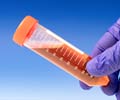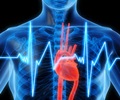Researchers state that the amino-acid, homocysteine, generally believed to contribute to heart attack, stroke and dementia has also been found to be involved in retinal damage and vision loss.
Researchers state that the amino-acid, homocysteine, generally believed to contribute to heart attack, stroke and dementia has also been found to be involved in retinal damage and vision loss.
Homocysteine levels rise when folic acid levels drop, a common problem for Americans whose diets are often poor in folate-rich fruits, tomatoes, vegetables and grains, according to Dr. Sylvia Smith, cell biologist at the Medical College of Georgia.Scientists want to know the impact of resulting elevated homocysteine levels on the extensive blood vessel and neuronal network of the retina; their preliminary evidence suggests that it isn’t good.
“You don’t have to be a cell biologist to see that there is a problem in this retina. It’s terribly disrupted,” Dr. Smith says, looking at images of a fragmented 10-layer retina exposed to high levels of homocysteine. A healthy retina – tissue at the back of the eye that receives light and transforms it to a neural impulse that goes to the brain – is “beautifully” organized, horizontally and vertically, she says.
“What is the consequence of slightly elevated homocysteine on the retina, on its architecture, its functioning, its ability to withstand stress?” Dr. Smith hopes to find the answers with a $1.8 million grant from the National Institutes of Health.
She and Dr. Vadivel Ganapathy, chair of the MCG Department of Biochemistry and Molecular Biology, have been studying how folate gets to the retina and how diseases such as diabetes interfere. They found it hard to ignore homocysteine as they studied folate, a vitamin essential to life.
Folate and vitamin B12 – which Americans typically get plenty of – convert homocysteine to methionine, an amino acid essential to protein synthesis.
Advertisement
They are studying a mouse model with a slightly elevated homocysteine level that simulates a low-folate diet in humans; a version of the mouse that also has diabetes, which goes hand-in-hand with cardiovascular disease and retinopathy; and a second model of the rare genetic defect that results in extraordinarily high homocysteine levels.
Advertisement
They hypothesize that sustained elevation will compromise retinal function and degrade the once well-stratified tissue. They have shown in pilot studies that adding diabetes to the mix makes bad matters worse.
“At any point in your life, too much homocysteine can be problematic, whether you are talking about pregnant women, cardiovascular disease or dementia,” says Dr. Smith. “If homocysteine is not converted into methionine or cysteine (by vitamin B6) to aid protein synthesis, it can do something bad.”
Dr. Ganapathy notes that people need only about 1 microgram per day of vitamin B12, which comes from microorganisms common in animals’ gastrointestinal tract. Strict vegetarians are typically the only Americans who have problems with B12 deficiency, he says. People need about 400 micrograms of folate daily. Pregnant women as well as those trying to become pregnant need at least double that.
Source-Eurekalert
GAN/V







